Menu
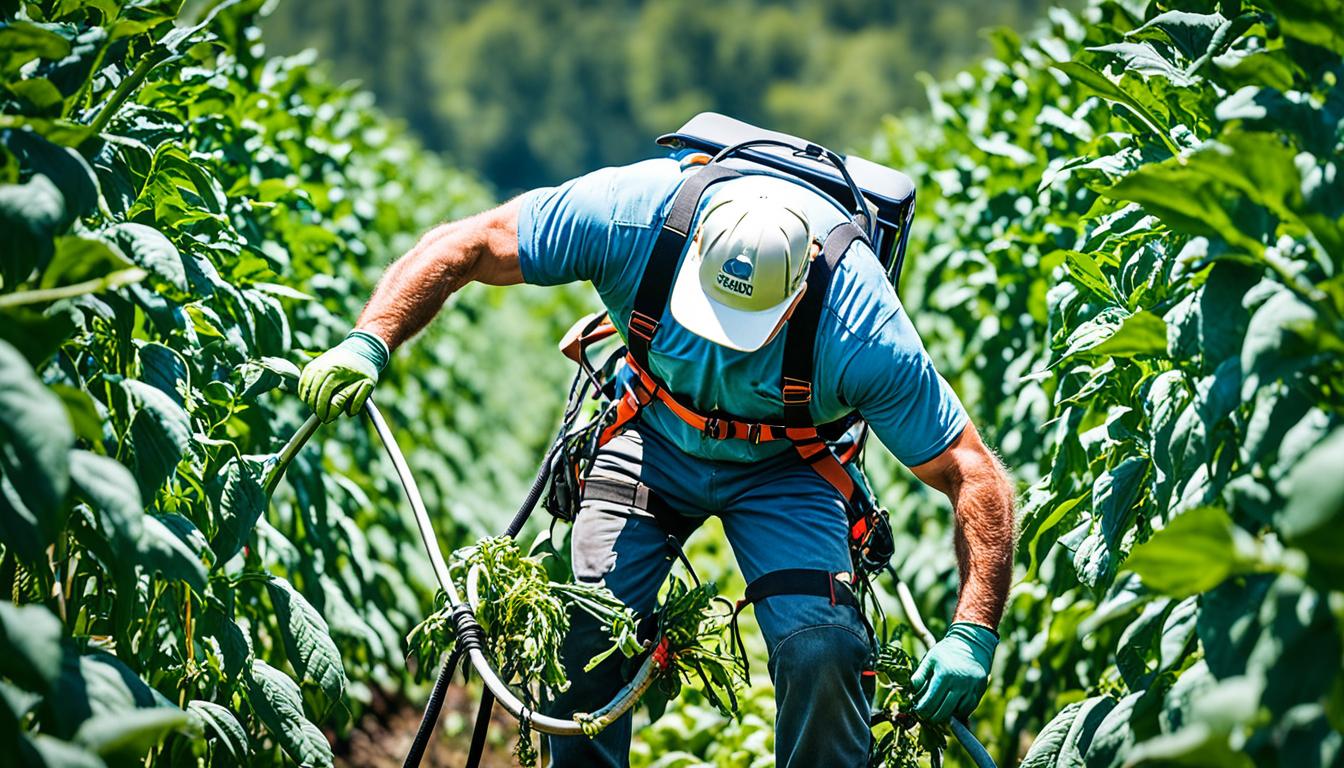
In Korea, nearly 85% of health problems for farmers are musculoskeletal disorders (MSDs). Back pain affects about 47%. These facts show the great need for better tools and practices in farming. About 52% of studies point to bending over a lot as a big issue in causing these problems.
Ergonomics is crucial for keeping farmers healthy and safe. It works to reduce risks like heavy lifting and repeated bending that lead to injuries. Using ergonomic equipment and tools can cut down these dangers.
Farmers and experts must together find solutions that really help. By improving how they work, farmers not only stay healthier but also work more effectively. This leads to better farming and helps the environment too.
Ergonomics in agriculture makes sure that farm workers are safe, comfortable, and efficient. This field focuses on matching the tasks with the workers, to prevent musculoskeletal disorders (MSDs). These include issues like back pain, which may arise due to the nature of farm work. Ergonomics helps improve both safety and productivity in farming, which is vital since it ranks second in work-related injuries and illnesses.
Musculoskeletal disorders (MSDs) are common but non-fatal issues in farming. They come from tasks like bending a lot or doing hard work. Making small changes can significantly lessen these problems. For example, using smaller tubs has helped in harvesting grapes with less pain for workers.
Other changes that help include shorter distances between ladder rungs and using tools with long handles. These adjustments reduce the need to bend or stoop, further lowering the risk of injury.
Ergonomics improves farmer health by tackling work-related musculoskeletal disorders (WMSDs). These are the most widespread work illnesses, affecting about 160 million people every year. For instance, in Korea, 84.6% of farming-related diseases are MSDs.
Common issues are back pain, knee, and shoulder problems. Ergonomic solutions, like using easier tools and taking more breaks, help reduce these issues. They improve worker health and increase how much work can be done.
Good ergonomic practices don’t just support worker health. They also cut down on sick days and make work more efficient. Evidence from research done between 2010 and 2019 confirms the positive impact of ergonomics in agriculture.
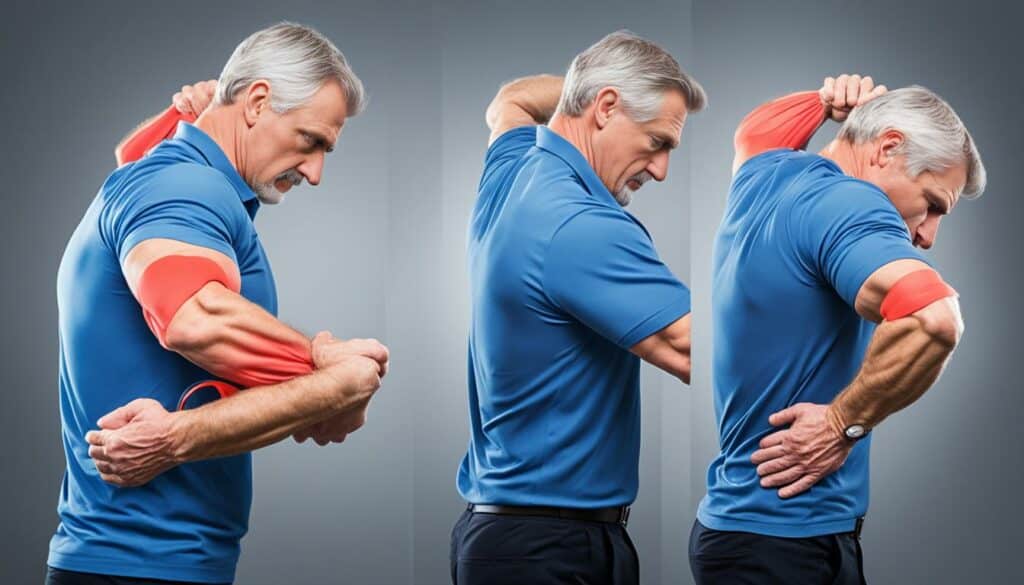
Work-related musculoskeletal disorders (WMSDs) are a major health concern in agriculture. The hard work and exposure to tough conditions in farming cause these issues. This means many farm workers face WMSDs often.
WMSDs in farming usually affect several body parts. Back pain, knee issues, and shoulder problems are common. The FARM study showed that 91.3% of farmers had muscle and joint pain. Among these, low back pain was the biggest problem for 63.8%.
This is because farmers often repeat the same hand movements, lift heavy things, and stay in uncomfortable positions.
In the FARM study, 53% of farmers had over 30 years of experience. This long time working contributed to their WMSDs. The study also found those in dry-field farming were most common (41.5%). Nearly 95% of them didn’t have education beyond high school.
About 36.3% of these farmers made less than 20 million won a year. This shows many face money issues, adding to their stress.
Working long hours without enough breaks makes WMSDs worse. An Iranian study found the same problem among pistachio farmers. It showed that age and health play a big role in these injuries.
In Thailand, studies have also warned about the high risk of WMSDs for farm workers. But, investing in safety could save a lot of money. For example, spending about $1397 per person on safety can cut costs by $3278 a year. This proves it’s vital to prevent these injuries.
Understanding the risks in crop harvesting is key to reducing physical strain. By spotting risks early, we can find ways to help farmers work better and feel healthier.
Farmers often strain themselves with repetitive tasks, heavy loads, bending, and strange postures. In Rajasthan, India, a study found that over 50% of manual harvesting farmers had musculoskeletal issues (MSDs). Their lower back, fingers, shoulders, and wrists were the most affected.
Lower back pain hit 73.6% of them, finger problems were at 64.2%, and 57.1% had issues with their shoulders. These figures show we need to act fast to stop these issues.
The environment also plays a big part in causing these problems. Issues like bad weather, machine vibrations, and loud noise add to MSD risks. Ergonomic factors are strongly linked to the high levels of musculoskeletal problems in farming worldwide.
Back pain is 1.5 times more common in agriculture than other US industries. And, MSDs in agriculture can be as high as 80 per 1,000 workers in vineyards. Compare this to 910 per 10,000 workers in underwear factories. It shows we must deal with these physical and environmental risks.
| Work Environment | Prevalence of MSDs | Key Physical Risk Factors | Key Environmental Risk Factors |
|---|---|---|---|
| Maharashtra, India | Over 50% | Lower back pain, finger and shoulder complaints | Extreme weather, machinery vibrations |
| Oil Palm Plantations, Melaka | 77.9% | Repetitive hand movements | Noise exposure |
| Vineyard Operations, US | 60 per 1,000 workers | Heavy lifting and bending | Year-round environmental exposure |
Knowing these risks lets us take real steps to ease the pain and deal with tough conditions. We aim for a safer, healthier workplace for farmers.
In agriculture, ergonomic interventions are vital. They help keep farmers healthy and productive. They focus on reducing the risk of musculoskeletal disorders during tasks like crop harvesting. The key methods are using personal protective equipment (PPE) and ergonomic tools.
PPE in farming protects workers from many dangers. This includes avoiding physical strain and environmental hazards. Items like protective gloves, knee pads, and back braces are crucial. They lower the chance of getting musculoskeletal disorders. For example, it’s found that 47.3% of Korean farmers face back pain. So, PPE is essential in combating these issues.
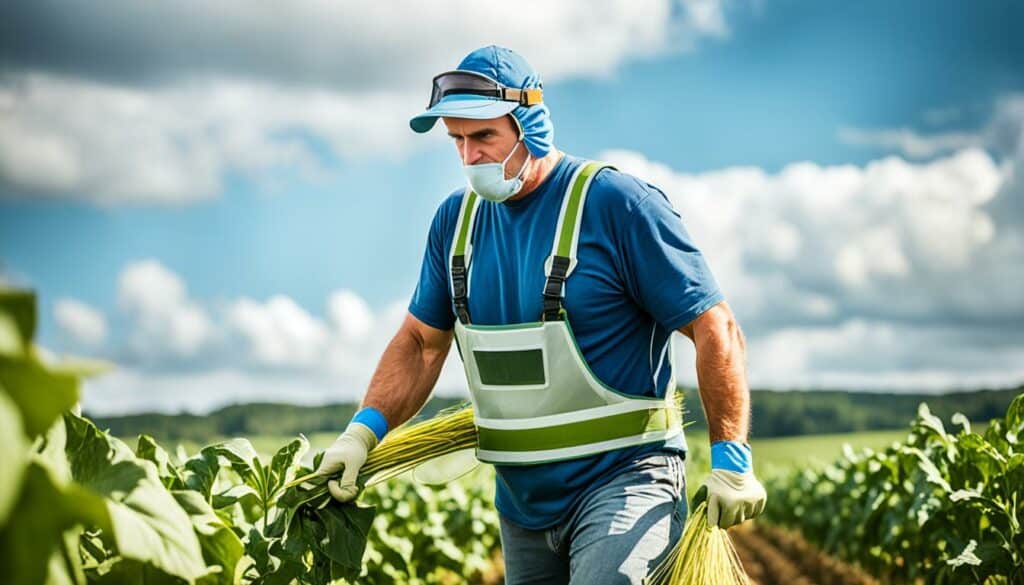
Ergonomic tools are key in making farming tasks safer. For instance, there are bags designed for coffee picking that ease strain on the body. These bags spread the weight evenly to reduce back and shoulder burdens.
There are also hand tools with better grips and longer handles. They cut down on repetitive motions, which lead to many musculoskeletal disorders. Farmers using these tools report fewer health problems.
Furthermore, tools with adjustable features help maintain good posture. This fights against the need to stoop or flex the trunk for long periods. These issues affect a large percentage of farmers. So, using the right tools is crucial for their well-being.
Involving farmers is key to making ergonomic solutions work well in farming. When farmers help design and put these solutions in place, things go better. They add their practical knowledge and experiences to make solutions that are efficient and easy to use.
Evidence shows that involving farmers makes ergonomic solutions work better. In Korea, for example, they improved working conditions for peach farmers. They involved farmers aged 59 to 78, each with over 30 years of experience, in the process.
This hands-on work identified major risks like stooping and carrying heavy loads, which can lead to injury. Later, farmers confirmed the success of these solutions in making work safer and more satisfying through a detailed questionnaire.
In The Gambia, for instance, 212 women in vegetable gardens helped choose the best solutions. This led to better health, more productivity, and lower chances of getting hurt. They picked leaders from the groups based on their farming and leadership skills, ensuring solutions were well-suited.
Similar stories exist in various places too. From coffee and orange harvesting to apple picking, the involvement of farmers in creating ergonomic solutions has shown significant benefits.
| Geographical Location | Task/Activity | Prevalence of WMSDs (%) | Ergonomic Intervention |
|---|---|---|---|
| Korea | Peach Farming | 84.6% (MSDs) | Work Analysis, Risk Identification, Implementation, Evaluation |
| The Gambia | Vegetable Gardening | – | Participatory Intervention Selection |
| Global | Various Agricultural Tasks | 51.9% (Harvesting activities WMSDs) | Ergonomically Designed Tools |
New ergonomic tools are changing agriculture, making work easier and more efficient. These include special harvesting bags and equipment that can be adjusted. They help farmers work better without hurting themselves or the environment.
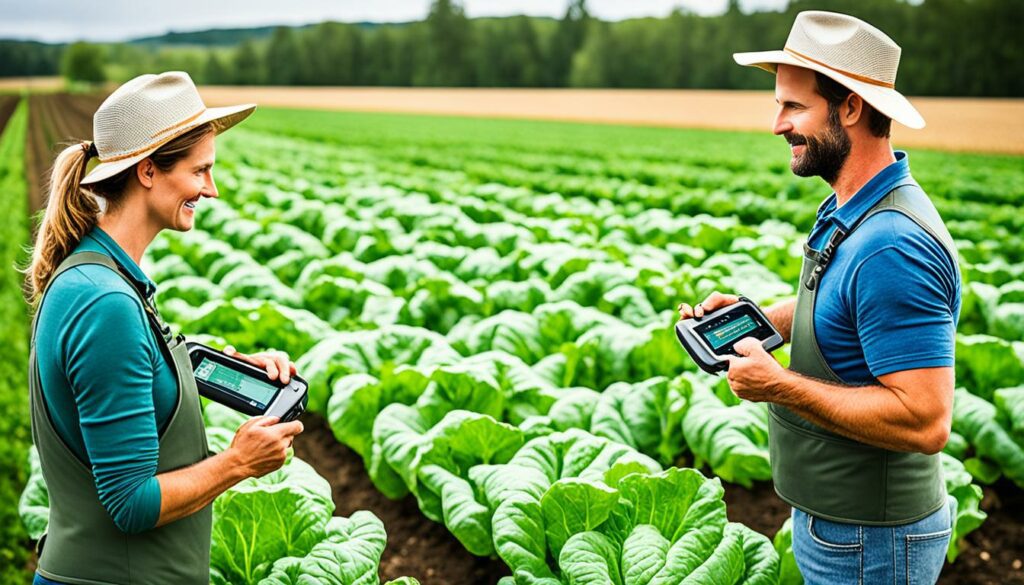
Harvesting bags are key in making farm work less tiring. They spread the load well, protecting backs and shoulders. In California, over 3,000 farm workers hurt their backs every year. Special bags like these can cut down on those injuries. They also help with back pain, tired shoulders, and sore arms.
Adjustable farming tools are a great step forward. They fit different people and body shapes, avoiding injuries. For example, tools with adjustable handles and using dollies for heavy things help. They keep the work at a safe level to prevent hurting the shoulders, hands, and back. These changes make life easier for workers and help get the job done more efficiently and safely. They’re vital for reducing the strain from the common actions in farming.
| Ergonomic Tool | Benefits |
|---|---|
| Ergonomic Harvesting Bags | Even weight distribution, reduced back and shoulder strain |
| Adjustable Farming Equipment | Accommodates different heights and postures, reduces musculoskeletal disorders |
Farmers need to reduce physical strain to stay healthy and productive. They often get hurt doing tough jobs, leading to backaches, and pain in the shoulders, arms, and hands. In California, back injuries alone cost more than $22 million yearly in workers’ compensation. Dealing with these issues requires a detailed plan.
It is vital to change when farm work happens. By shifting the hardest tasks to cooler times or when workers are less tired, we can reduce the chance of injuries. This also improves the flow of work and how much gets done.
Farmers should take enough breaks to let their muscles rest. This helps lower the risk of getting hurt. Around a third of missed workdays happen because of these injuries. Being strict about taking breaks during the day makes farm work safer and more efficient.
These methods help keep farm workers both healthy and productive. Starting with small adjustments and focusing on rest can lead to big improvements in worker health. This is key for the future of farming.
| Injury Type | Prevalence | Cost Impact (California) |
|---|---|---|
| Back Injuries | 25% | $22 million annually |
| Sprains and Strains | 33% | Significant lost workdays |
| Work-Related Musculoskeletal Disorders | Leading cause of disability | High compensation costs |
Boosting how well manual workers harvest crops is crucial. It makes farming more productive and keeps workers safe. To do this, we need to support training and bring in machines for some tasks.
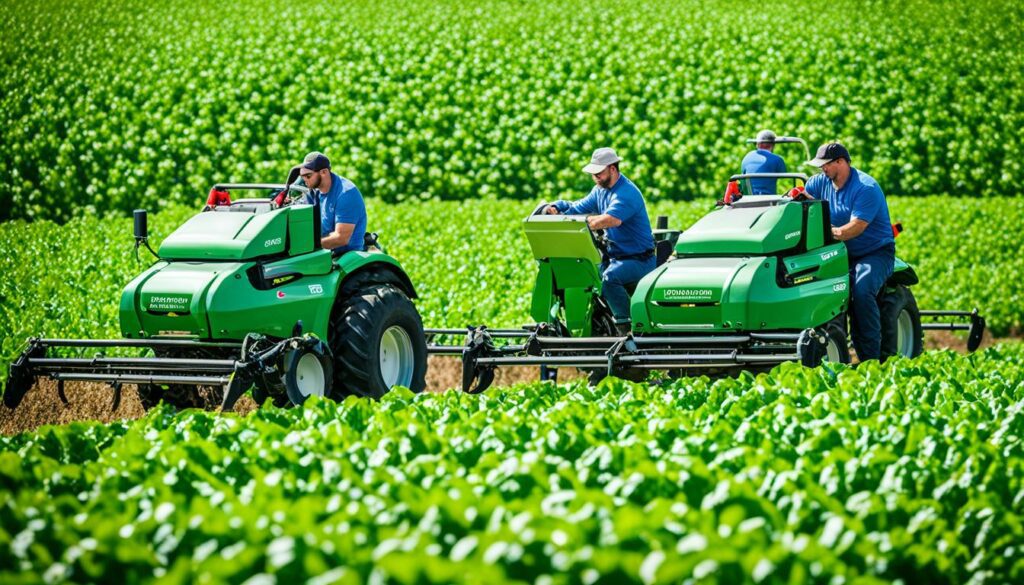
Training farmers is key to better crop picking. They learn how to avoid getting hurt, especially their muscles and bones. This is by teaching them how to lift things safely, keep a good posture, and use special tools.
The International Labour Organization reports around 160 million work-related illnesses per year globally, with WMSDs featuring prominently. Ergonomic training can drastically reduce such adverse health outcomes in agriculture.
Using machines to do repetitive farm jobs helps a lot. This means machines sort, pack, and help harvest crops. It makes the work less physically hard for people, prevents long-term injuries, and gets things done faster and better.
In California agriculture alone, annual workers’ compensation costs for over 3,000 back injuries may exceed $22 million. Automation can help reduce these financial burdens by minimising incidences of strain and injury.
Pairing up machines with good farming training is a big step forward. It makes work safer and more efficient for farmers all over the world. They will be healthier and get more work done.
In the world of sustainable agriculture practices, it’s key to use eco-friendly ergonomic innovations. They aim to protect farmers’ health and keep farming going for the long haul. These solutions are carefully crafted to do both.
Recent research shows the big impact of eco-friendly ergonomic innovations in farming. Every year, about 160 million farmers get work-related health issues. Much of this is due to body strain from repetitive tasks. Ergonomic tools and PPE can help ease this strain.
In Korea, 5.0% of farmers had work diseases in 2020. More than 84.6% of these were musculoskeletal disorders. Back pain, caused by heavy lifting, is a big issue. Designing ergonomic solutions can help farmers work safer and more comfortably.
Getting into sustainable agriculture practices brings big, long-lasting perks. These ergonomic solutions check health issues right away. They also help keep farming going strong over time. For example, giving breaks can reduce stress on the body.
A full view of ergonomics in farming means better tasks for farmers. This not only keeps them healthy but makes farms better for nature. It also helps farms flourish for years. Getting farmers involved in designing these changes makes them even more helpful and likely to be used.
In agriculture, it is important to do thorough ergonomic assessments. They help find and lessen the risks of musculoskeletal disorders (MSDs). Farmers’ postural loads and muscle strains are looked at in these assessments.
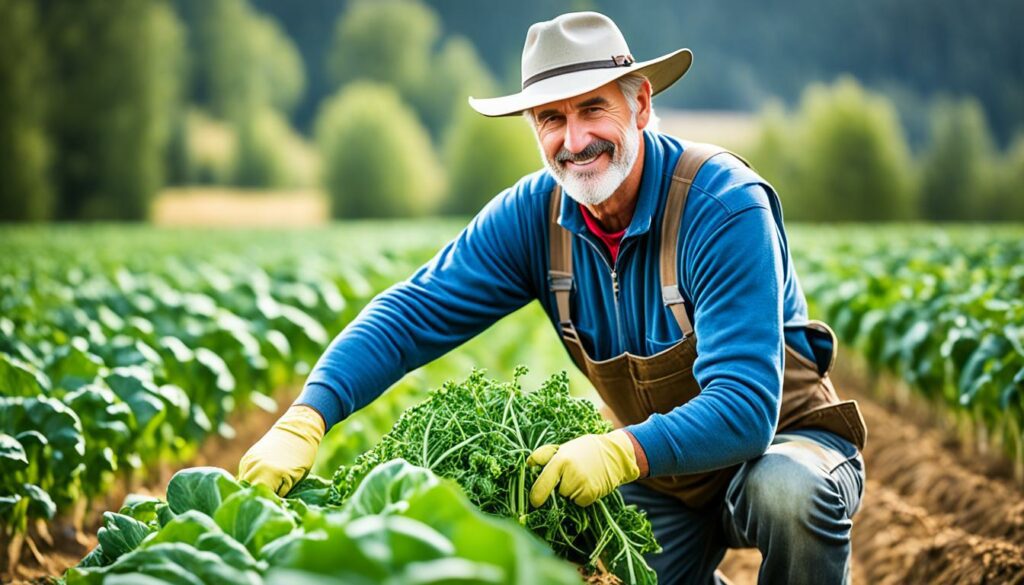
The Rapid Upper Limb Assessment, or RULA, is a key method. It looks at the risks in how farmers hold their upper limbs, neck, trunk, and legs. This method is great for spotting bad postures that could cause MSDs.
An example is finding out how to avoid low back pain, a common issue for farmers.
There are more tools and methods than just RULA. They focus on specific tasks in farming. For example, using smaller grape harvesting tubs and closer ladder rungs has reduced a lot of pain. This approach also includes tools like long-handled hoes. They help workers bend less and do more efficiently.
Let’s take a look at how different changes have helped:
| Intervention | Impact |
|---|---|
| Smaller tubs for harvesting grapes | Significant reduction in pain |
| Reducing the space between rungs in ladders | Enhanced safety and pain reduction |
| Long-handled hoe for weeding | Decreased trunk flexion, increased productivity |
| Pneumatically-powered cutters | Enabled workers with partial disability to resume tasks |
| Frequent breaks during labour | Temporary relief from physical strain |
| New bag and lumbar-shoulder belt mechanism | Improved comfort but highlighted size issues |
Using these assessments and methods helps improve farm workers’ lives. By making farmers’ jobs safer and more effective, everyone benefits.
Improving ergonomics in farming is crucial. Farmers often suffer from health issues due to their work. For example, 84.6% of diseases among Korean farmers in 2020 were musculoskeletal.
Studies show that using ergonomic tools can help. They make farming tasks easier and safer. This is a big step towards better health for farmers.
A study focused on nine Korean farmers aged 59 to 78. They had decades of farming experience. The study used the RULA method to check how certain tools improved their work posture.
Results were impressive:
These findings highlight the power of ergonomic tools. From bags for coffee picking to tools for harvesting oranges, many devices can make work safer.
These studies underscore the need for farmers to be part of the solution. When they help design and use ergonomic tools, improvements are more likely. This leads to tools that fit the real needs of farm work.
Targeting dangerous tasks like harvesting is key. About 51.9% of farm-related health issues come from this. Because of this, addressing posture, repetitive tasks, and lifting is important.
| Ergonomic Intervention | Impact |
|---|---|
| Ergo Bucket Carrier (EBC) for carrying | 41% reduction in LBD risk |
| EBC for dumping | 69% reduction in LBD risk |
| Easy Lift (EL) for lifting | 55% reduction in LBD risk |
| Ergonomically designed harvesting bags | Reduced musculoskeletal strain |
By using ergonomic methods, farms can be safer and more productive. These studies guide us on using tools effectively. They also stress the importance of farmers’ input for a successful plan.
Technology is key in improving farming jobs to avoid injuries like WMSDs. Farming ranks high in injuries, so using advanced equipment is crucial for safety. This tech makes farming both safer and more efficient.
A lot of farm workers get musculoskeletal disorders, especially in the back, knees, and hips. These not only make life harder but also cost a lot in healthcare and support. So, using new tech helps solve these problems.
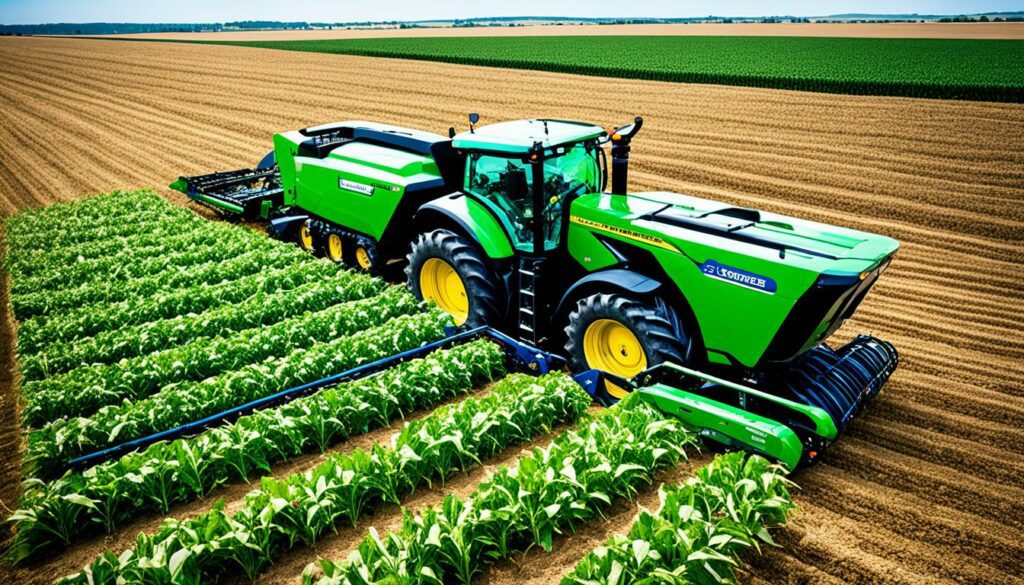
New ergonomic farming gear makes tasks easier and reduces strain. For example, special cutters and hoes make work less tiring. Even small changes, like using smaller tubs for grapes, can cut down on worker pain a lot.
Smart farming mixes high-tech machines with smart data to make better choices. With these solutions, farming tasks can be automatic, lessening the hard work. Plus, using adaptable tools and machines makes jobs easier and more efficient. These advances fit the needs of different crops, making farming safer and greener.
Improving farming techniques with new technology is crucial for lowering MSD rates. By focusing on smart farming and better equipment, we can support farm workers better. This helps cut down on health and money issues caused by WMSDs.
Despite their known advantages, ergonomic solutions face several obstacles to being used widely in agriculture. Overcoming these hurdles is vital for better health, safety, and efficiency for farmers.
The high cost of ergonomic solutions proves a major challenge. Even though these solutions promise to lessen body strain and boost output, their cost is too high. This is especially true for farmers working with limited funds. Ergonomic tools and machines require a big upfront investment. This poses a problem for smaller farmers. They often find it hard to afford or justify these costs.
A big barrier is the lack of awareness and training on ergonomics in farming. Many don’t know about the risks such as repeated motions, kneeling, and lifting. This lack of understanding means some farmers ignore early signs of muscle and skeletal issues (MSDs) until it impacts their work. Increasing understanding through education and integrating ergonomic training into their routine activities could boost adoption rates.
Sharing the knowledge about ergonomic solutions’ advantages and how to implement them cost-effectively is key. I suggest offering thorough training on both the usage of ergonomic equipment and the savings from fewer injuries. Overcoming these obstacles would mean a great deal for farmers’ well-being and their work’s efficiency.
Having good support from policies is key to making farming safer for workers. Making rules on how to work best can stop many muscle problems. This means people are less likely to get hurt at work. It’s the job of the government to make sure farmers have what they need to be safe.
Strong government support is needed to keep farmers safe. With clear rules, governments can lower the money needed for things like workers’ compensation. A good example is in California, where many back injuries cost lots of money each year. By making changes to how work is done, these injuries can be avoided.
Organisations that help farmers are big in promoting better working habits. They teach farmers why it’s important to work in the right way. They also give out helpful guides like the Ergonomics for Farm Workers booklet. This booklet shares easy and cheap ways to work without getting hurt.
These groups also work closely with farmers to find ways to work better for them. By working together, they make sure the solutions are both doable and helpful. This makes the farm a safer and more productive place.
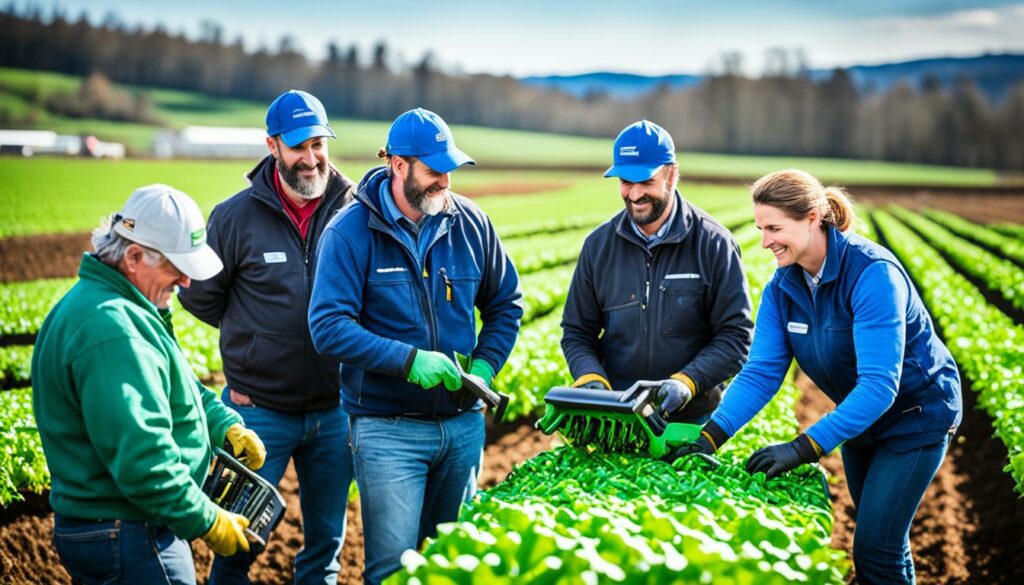
In summary, making farming safer needs everyone to work together. This means good rules, strong government help, and support from farming groups. With these efforts, we can keep farm workers healthy and farms running well for a long time.
Ergonomic solutions in crop harvesting are vital for the health and productivity of farm workers. Agriculture is the second most dangerous job, facing many injuries and sicknesses. These ergonomic methods help lower back pain and diseases like osteoarthritis, which are common among those in rural jobs.
Using ergonomics in farming can significantly reduce worker pain. Measures such as smaller grape tubs, long-handled weeding tools, and special carrying equipment show clear improvements. It also highlights the value of taking regular breaks from hard work.
Ergonomic changes benefit both the workers and the farm’s overall performance. These methods can lead to fewer illnesses worldwide, with about 160 million cases each year. By raising awareness and implementing better practices, the farming industry can become safer and more efficient. This would be a win for everyone involved.
Ergonomics in farming is key to cutting down on muscle and joint problems. It fits jobs to the people doing them. This means work is safer, more comfortable, and gets done better.
Ergonomics in farming lowers the chances of muscle and joint issues. This keeps farmers healthy and working. It also makes their work more effective because they use better methods.
Common muscle and joint problems in farming are backaches, knee issues, and shoulder pains. These come from tasks like lifting, bending, and doing the same hand movements over and over.
Harvesting crops can lead to heavy lifting, bending, and using your hands a lot. The weather and machine vibrations with noise are also big risks. They all play a part in causing muscle and joint problems.
PPE and ergonomic tools are vital for keeping farmers safe from injury. For example, there are special bags for holding coffee or tools that reduce stress on the body while working.
Involving farmers in finding ergonomic solutions makes sure they work in real farm situations. This way, the solutions are more likely to be used and help. It also helps farmers to feel part of the process.
There are bags for harvesting made in ways that cause less strain. Tools and machines that can change to fit the user are also helpful. Plus, new ergonomic equipment all reduce the toll on the body.
Planning work to avoid very tiring activities for too long, having breaks, and using eco-friendly ergonomic solutions are good steps. They help keep farm workers healthy and farming practices kind to the environment.
Teaching workers ergonomic techniques and using machines for repetitive tasks can help. This makes work easier and more efficient. It also means less strain on the workers.
Being eco-friendly and ergonomic in farming keeps farm workers healthy and the land in good shape. This approach also leads to long-lasting, productive farms.
RULA checks how work postures affect the body and the load on muscles and joints. It spots risks and guides on how to lessen them.
Studies highlight what works well in ergonomics, offering practical examples and learnings. They’re a great help for planning future ergonomic strategies in farming.
Technology brings in new, better tools and farming methods that make work easier. It uses smart machines and data to make ergonomic choices.
Costs and not knowing enough are common problems. Overcoming these with good training and cheaper ergonomic options is crucial for getting more farmers to use them.
Governments and groups in agriculture help with rules, money, and learning materials. These actions encourage a safer and more ergonomic farming space.